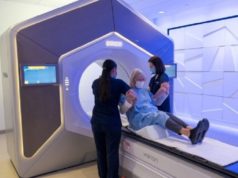
Irreversible electroporation (IRE) significantly induces a window of reduced immune suppression two weeks post treatment, allowing the activation of effector T cells that seem to be correlated with improved survival, according to preliminary flow cytometry results of the CROSSFIRE trial (NCT02791503 on clinicaltrials.gov). Speaking during the 2020 meeting of the Cardiovascular and Interventional Radiological Society of Europe (CIRSE; 12–15 September, virtual), Bart Geboers (Amsterdam UMC, Amsterdam, The Netherlands) described how his team investigated the immune modulatory effects of IRE and MR-guided stereotactic ablative body radiotherapy (SABR) in patients with locally advanced pancreatic cancer.
Pancreatic cancer is one of the most aggressive cancers, Geboers informed the CIRSE audience, with a five-year overall survival of less than 10%. Thirty percent of all patients present with locally advanced disease, and are not amenable for surgical resection. The median overall survival for patients with locally advanced pancreatic cancer is approximately 12–14 months. “The problem with pancreatic cancer is that it is barely immunogenic, and the tumour cells can escape the immune system,” Geboers explained. “This might explain the disease aggressiveness.”
Describing the pathophysiology of the cancer, he said the low immunogenicity is “probably two-fold”: the cancer suppresses the tumour microenvironment, and is associated with a lack of spontaneous apoptosis.
In terms of suppressing its microenvironment, the tumour releases suppressive cytokines that induce activation and proliferation of specific T cell subsets that are immunosuppressive—regulatory T cells (Tregs) and myeloid-derived suppressor cells (MDSC). In turn, these reduce the activation and proliferation of effector T cells, including Helper T cells (CD4) and cytotoxic T cells (CD8), thereby providing the tumour with a “T cell tolerance”.
The second problem is the rarity of spontaneous tumour cell apoptosis. This means no epitopes are released that can be taken up by dendritic cells and used by the immune system to develop an adaptive response in the lymph nodes.
Altering the immune balance of the tumour microenvironment
Overcoming tumour-induced immune suppression is therefore difficult. Geboers and colleagues hypothesised that ablation can alter the immune balance, changing the microenvironment from an immunosuppressive one to a more immunopermissive one. “We know that ablation results in a reduction in the tumour mass, and so a reduction in suppressive cytokines. This will lead to a reduction in T cell tolerance, and allow the development of effector T cells,” he explained. In addition, ablation induces apoptosis and necrosis, meaning there will be a release of immunogenic epitopes that can be taken up by antigen-presenting cells. Furthermore, “IRE has the advancement of being vessel sparing,” Geboers said, so antigen-presenting cells can transport epitopic antibodies to lymph nodes, where an adaptive immune response can occur.
To test this thinking, the investigators conducted an Immunological side study of the CROSSFIRE trial, where pancreatic cancer patients were prospectively enrolled between January 2016 and February 2020. Patients with locally advanced pancreatic cancer were pre-treated with FOLFIRINOX, before being randomised between IRE or SABR.
Tumour microenvironment shifts to become more immunopermissive two weeks after IRE, but this is lost by three months post-IRE
In order to assess the immune response, Geboers and colleagues took a venous blood sample from each patient before IRE or SABR, two weeks after treatment (to evaluate the immediate response), and three months post-treatment (to evaluate the durable immune response). Flow cytometry analysis was used to detect the type, frequency, and activation status of circulating immune cells.
A T cell analysis of 36 patients (19 treated with IRE, 17 with SABR) revealed that, two weeks after IRE, there was a significant downregulation of the regulatory T cells in the peripheral blood flow, as predicted by Geboers and colleagues. This downregulation returned to baseline three months after IRE. There was a trend for down regulation of the regulatory T cells three months after SABR, though this was not significant.
The investigators next looked at checkpoint expression of CD4 and CD8 T cells (the effector or helper T cells that were suppressed by the tumour’s activities). Two weeks after IRE, there was a significant upregulation of PD1 on the CD4 T cells. All the other checkpoints remained low. None of the checkpoints were significantly upregulated in the SABR group at any time point following ablation. “When looking at the activation status of the CD4 and CD8 T cells, we found that Ki67, which is a marker for T cell activation, was significantly upregulated at two weeks after SABR, in both CD4 and CD8 T cells, but was only significantly upregulated on the CD8 T cells two weeks after IRE ablation,” Geboers shared.
A linear regression model demonstrated that an increase in PD 1, on both CD 4 and CD8 T cells two weeks after IRE, was significantly associated with improved overall survival. No significant correlation was seen between PD 1 upregulation and overall survival in the SABR group.
“We found a significant downregulation of regulatory T cells two weeks after IRE that was simultaneous with a PD 1 upregulation on CD 4 T cells,” Geboers summarised. “The fact that the expression of the other checkpoints remained low argues against T cell exhaustion, but rather indicates that we are looking at a real effector T cell activation that might be amenable for PD 1 blockade with checkpoint inhibitory drugs.”
The CIRSE audience were left with this promising take-home message: transient PD 1 T cell upregulation combined with simultaneous regulatory T cell decrease after IRE is consistent with previously described systemic immune stimulatory effects of IRE, and supports combination with pharmacologic PD 1 checkpoint inhibition.
“These findings warrant further studies, for which we designed the PANFIRE III trial,” Geboers told delegates (NCT04612530 on clinicaltrials.gov). This will be a Phase I trial in which 18 patients with oligometastatic pancreatic cancer will be included. The study has three arms: the first six patients will be treated with Nivolumab (a PD 1 blockade; this is the control); the second six patients will be treated with IRE ablation of the primary tumour followed by Nivolumab; the final six patients will be treated with TLR-9 ligand intra-tumoural injection, followed by incomplete IRE ablation of the primary tumour and Nivolumab.











